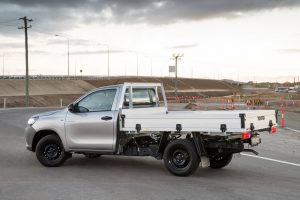Recalls: Toyota Mk.8 Hilux Cab Chassis
Overview
Manufacturers, or importers, issue recalls for defects or faults which have the potential to cause injury. Generally, manufacturers will inform the original buyers if their vehicle is subject to a recall and of the steps required to remedy the defect or fault. Please note that the recalls below (if any) are for Australian-delivered vehicles only. Furthermore, the number of recalls should not be taken as an indication of a model’s reliability or its safety more generally.
Recalls: Toyota Mk.8 Hilux Cab Chassis
2015-17 Toyota Hilux 4×4 and 4×2 Hi-Rider Diesel with Auxiliary Battery Kit
In May 2017, a recall was issued for Toyota Hilux 4×4 and Hilux 4×2 Hi-Rider vehicles that
- Were manufactured from 29 September 2015 to 14 January 2017;
- Had diesel engines; and,
- Were fitted with a Toyota Genuine Accessory Auxiliary Battery Kit.
These vehicles may experience damage to the mounting points on the fender apron from vibrations that occur when driving on rough roads. Damage to the mounting points could cause the auxiliary battery assembly to move and interfere with the engine wire harness – this could damage the wires, cause warning lights to illuminate and potentially cause the engine to stall. For the VINs of the recalled Toyota Hilux vehicles, please see PRA 2017/16046.
2015 Toyota Mk.8 Hilux: airbags could be de-activated
In February 2018, a recall was issued for Toyota Mk.8 Hilux vehicles that were manufactured from 30 June 2015 to 1 December 2015. Over time, insulation layers of the Integrated Circuit (IC) chip within the airbag system could peel and create an open circuit in the IC chip. If this occurred, the airbag warning light would illuminate and the side/curtain and/or front airbags could be de-activated – this increased the risk of occupant injury in the event of a collision. For the VINs of the recalled Toyota Mk.8 Hilux vehicles, please see PRA 2018/16585.
2017-19 Toyota Mk.8 Hilux: low-pressure fuel pump may stop working
In April 2020 and November 2020, recall campaigns VGG17 and VGG05 were issued for Toyota Mk.8 Hilux vehicles that were manufactured from September 2017 to May 2019. In these vehicles, the low-pressure fuel pump could stop operating – if this occurred, the engine may stall and the vehicle may not restart; alternatively, the engine may not run smoothly. Beyond this, warning lights and messages may be displayed on the instrument panel. To fix, the low-pressure fuel pump was to be replaced. For the VINs of the recalled vehicles, please see PRA 2020/18242.
2020 Toyota Mk.8 Hilux cab chassis: missing compliance label
In November 2020, recall campaign VGG77 was issued for 2020 Toyota Mk.8 Hilux vehicles. Australian Design Rule (ADR) 61/02 requires that a compliance label is fitted at the specified location of a new vehicle. The recalled Toyota Mk.8 Hilux vehicles did not comply with ADR 61/02 because a compliance label was not fitted. For the VINs of the recalled vehicles, please see PRA 2020/18677.
2018-20 Toyota Mk.8 Hilux Cab Chassis Diesel: brake booster fault
In December 2020, recall campaign VGG75 was issued for Toyota Mk.8 Hilux Cab Chassis vehicles that had diesel engines and were available for sale in Australia from 7 August 2018 to 12 August 2020. The brake boosters for these vehicles may have been incorrectly manufactured, causing an internal fault. If the brake pedal was repeatedly used whilst driving, braking assistance may be lost – this could increase the vehicle stopping distance and the risk of a collision. For the VINs of the recalled vehicles, please see PRA 2020/18714.
2019-20 Toyota Mk.8 Hilux 4×2 Hi-Rider: incorrect compliance label
In March 2021, recall campaign A1S04 was issued for Toyota Mk.8 Hilux 4×2 Hi-Rider vehicles that were produced from April 2019 to May 2020. For these vehicles, the compliance label was printed with an incorrect Gross Vehicle Mass (GVM) of 2850 kg, instead of the correct GVM of 3050 kg. As a result, the vehicle was not compliant with Australian Design Rule 61/02. To fix, the compliance label was to be replaced. For the VINs of the recalled vehicles, please see PRA 2021/18870.
2021 Toyota Mk.8 Hilux: incorrect GVM capacity on compliance label
In August 2021, recall campaign A1S12 was issued for Toyota Mk.8 Hilux Rogue Dual Cab 4×4, Rugged X Dual Cab 4×4, SR5 Dual Cab 4×4 and SR5 Dual Cab Hi Rider 4×2 variants. For these vehicles, the compliance label may have had an incorrect GVM (Gross Vehicle Mass) Capacity and therefore did not comply with Australian Design Rule 61/02. For the VINs of the recalled vehicles, please see REC-001688.
2015-21 Toyota Mk.8 Hilux: licence plate may dislodge
In December 2021, recall campaign WGG76 was issued for 2015-21 Toyota Mk.8 Hilux vehicles, specifically the Workmate, Rogue, Rugged, Rugged X, SR and SR5 variants. Due to poor stiffness of the rear licence plate braket around its single mounting point, cracking could result from metal fatigue that was caused by vibration when driving on rough (corrugated) roads. In this condition, the licence plate wiring may sever and the licence plate may dislodge from the vehicle. If the rear licence plate bracket became detached from the vehicle while it was being driven, the risk of a collision would be increased. To fix, Toyota dealers were to replace the licence plate bracket. For the VINs of the recalled vehicles, please see REC-005004.
2021 Toyota Mk.8 Hilux Workmate and SR: faulty passenger seat occupant sensor
In December 2021, recall campaign WGG95 was issued for 2021 Toyota Mk.8 Hilux Workmate and SR variants. The passenger seat occupant sensor – which was used to detect if the seat was occupied and whether to deploy the passenger airbag in the event of a collision – may not meet manufacturing specifications. To fix, a Toyota dealer was to inspect and, if required, calibrate, the occupant sensor. If the sensor did not operate as intended, the airbag may not deploy when required and this would increase the risk of injury. For the VINs of the recalled vehicles, please see REC-005030.
Problems and faults: Toyota Mk.8 Hilux Cab Chassis
Overview
This section identifies potential problems, causes and fixes based on the experiences of owners and repairers, online sources and technical service bulletins. This information is provided solely for reference purposes and AustralianCar.Reviews recommends that only properly qualified persons carry out repairs or modifications. Furthermore, the number of items below should not be taken as an indicator of a model’s reliability or the frequency with which they may occur.
To report a problem or fault to the AustralianCar.Reviews team, please use the Contact Us form. Note that AustralianCar.Reviews does not offer advice on automotive problems or disputes; such enquiries will not receive a reply. For vehicles purchased from dealers after 1 January 2011, please see our Australian Consumer Law fact sheet.
2015-16 Toyota Mk.8 Hilux: driveline clunk and tailshaft replacement
For Toyota Mk.8 Hilux vehicles, owners have reported hearing a thud/thunk/clunk noise from the tailshaft when shifting from park into reverse or drive, or when accelerating from rest. Initially, Toyota dealers attempted to address this noise by removing the tailshaft splines and re-greasing them, though this did not resolve the problem. Ultimately, the tailshaft needed to be replaced (part number 37100-0K820-00).
It is understood that the tailshaft noise was due to a production fault whereby the blades that cut the splines were not replaced regularly enough, causing poorly machined splines. It is understood that the blades were replaced more frequently from late 2016. For a discussion of this problem, please see NewHilux.net: 2016 Hilux Tail-shaft Thud/Thunk/Clunk.
2015-17 Toyota Hilux: clogged diesel particulate filter (DPF) and ECU re-program (GGG38)
In June 2017, Toyota initiated service campaign GGG38 to re-program the Engine Control Unit (ECU) for Toyota Mk.8 Hilux vehicles that had 1GD-FTV engines. To reduce NOx emissions, the 1GD-FTV engine had a diesel particulate filter (DPF). Over time, soot would accumulate on the DPF and a ‘regeneration’ process would be required to burn it off. Specifically, the fuel injectors would inject diesel fuel into the cylinders after combustion to raise the temperature of the exhaust gases (sometimes referred to as a ‘DPF burn’).
Service campaign GGG38 re-programmed the ECU to further increase exhaust gas temperatures and the duration of the DPF regeneration process to reduce the likelihood of the DPF becoming clogged. If the DPF became clogged and the vehicle could not initiate the regeneration process, then the DPF would have to be replaced.
Toyota Mk.8 Hilux Diesel: DPF regeneration switch
In August 2018, a Diesel Particulate Filter (DPF) regeneration switch was introduced for Toyota Mk.8 Hilux vehicles with 2.4- and 2.8-litre diesel engines so that the driver could manually initiate DPF regeneration. According to Toyota, the switch was introduced because the DPF could become clogged if the conditions for DPF regeneration were not met (i.e. the vehicle was not driven long enough at high speeds).
In December 2018, Toyota Australia sent a letter to owners offering to retrofit this DPF regeneration switch to pre-August 2018 vehicles.
Toyota Mk.8 Hilux with 2.8-litre 1GD-FTV diesel engine: ‘limp home’ mode due to dust
In March 2017, Toyota Australia issued a service bulletin for Toyota Mk.8 Hilux vehicles with the 2.8-litre 1GD-FTV diesel engine because fine dust particles could pass through the air filter and electrostatically attach to the mass air-flow (MAF) sensor. The MAF sensor would then provide invalid measurements to the engine control unit (ECU), which would cause the ECU to put the engine into ‘limp home’ mode – this reduced engine power and disabled the electronic stability control and traction control systems. Depending on the model, a message in the instrument panel may instruct the driver to visit a Toyota dealer or consult the owner’s manual.
According to the service bulletin, the air filter should be cleaned more frequently than prescribed in the service schedule if the vehicle as to be driven in dusty conditions. The bulletin also described a two-minute procedure to spray compressed air past the MAF sensor to clean it.
Toyota Mk.8 Hilux: steering wheel wear
For the Toyota Mk.8 Hilux, there have been reports of premature wear to the rim of the steering wheel, including pitting. As a result, Toyota dealerships have been replacing steering wheels under warranty.




